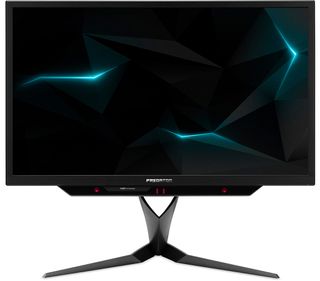Asus and Acer delay feature-rich 4K 144Hz monitors with HDR until 2018
These monitors can't get here fast enough.

When Acer announced its decked out Predator X27 monitor last April, it referred to the display as a "jaw dropping showstopper." We'd be hard pressed to argue otherwise based on the spec sheet alone, though whether or not the hype lives up to the billing is something we'll have to wait until next year to find out. That's because Acer is delaying the launch of this bad boy until the first quarter of 2018.
Same goes with Asus and its ROG Swift PG27UQ that was announced around the same time. After seeing a Twitter post for Acer announcing the delay of its Predator X27, we reached out to Asus to see where it stood with its own beastly 4K monitor. Sure enough, Asus told us that its monitor will release next year as well. Drats!
Neither company said why it's taking so long to bring these much anticipated monitors to market, and neither one had an exact release date to share. Regardless, waiting until next year is a bummer because we're really looking forward to these monitors.
To recap, the Predator X27 sports a 27-inch panel (Anandtech says it's an IPS panel) with a native 4K resolution (3840x2160) at a blazing fast 144Hz. Beyond those specs, Acer ticks just about every box you could want when shopping a gaming monitor. Here are some highlights:
- HDR10 support
- Nvidia G-Sync support
- Nvidia's ULMB (Ultra Low Motion Blur)
- Tobii eye-tracking technology
- 384 individually controlled LED lighting zones
- 100 percent coverage of the sRGB color space
- 1,000 nits brightness
- 4ms response time
This is a beastly monitor that should be capable of delivering some amazing visuals with excellent color reproduction, bright whites, and deep blacks. That is, if the actual performance matches the specs. Gaming should be buttery smooth too, thanks to its 4ms response time and incorporating G-Sync into the mix.
The spec sheet for the ROG Swift PG27UQ is virtually the same, right down to the number of LED lighting zones. Our guess is Acer and Asus are sourcing the panel from the same manufacturer and then slapping their own custom firmware and on-screen display (OSD) controls.
Beyond the exact release date, the big question here is price. Given the allotment of features, we suspect these monitors will sell for north of $1,000, and perhaps in the vicinity of $1,500. Assuming prices are comparable, the winner might be the one that can get to market first.
PC Gamer Newsletter
Sign up to get the best content of the week, and great gaming deals, as picked by the editors.
Paul has been playing PC games and raking his knuckles on computer hardware since the Commodore 64. He does not have any tattoos, but thinks it would be cool to get one that reads LOAD"*",8,1. In his off time, he rides motorcycles and wrestles alligators (only one of those is true).
Most Popular







